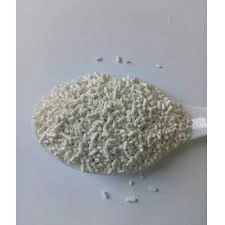
sodium acid pyrophosphate in food
Understanding Sodium Acid Pyrophosphate in Food
Sodium Acid Pyrophosphate (SAPP) is a widely used food additive that plays several crucial roles in the food industry. As a sodium salt of pyrophosphoric acid, this compound is often utilized for its unique properties, including pH control, leavening, and stabilizing capabilities. In this article, we will explore the functions of SAPP, its applications in various food products, safety concerns, and regulations governing its use.
What Is Sodium Acid Pyrophosphate?
Sodium Acid Pyrophosphate is an inorganic compound with the formula Na2H2P2O7. It appears as a white, granular powder that is soluble in water. It is primarily used as an acidulant, which means it provides a sour taste when added to food products. Moreover, it acts as a leavening agent in baked goods, enabling them to rise and achieve desirable textures. The ability of SAPP to release carbon dioxide when mixed with alkaline substances makes it valuable in the production of fluffy, light baked goods.
Applications in Food Products
SAPP finds its way into a multitude of food items. Its versatility makes it a popular choice in both commercial food production and home cooking. Here are some of the common applications
1. Baked Goods SAPP is frequently employed in baking powder formulations. It reacts with baking soda (sodium bicarbonate) to release carbon dioxide gas, providing the necessary lift in cakes, muffins, and quick breads.
2. Processed Potatoes In products like dehydrated potato flakes and instant mashed potatoes, SAPP helps maintain the texture and color of the potatoes, preventing browning and enhancing shelf-life.
sodium acid pyrophosphate in food

3. Canned Foods The additive is sometimes included in the processing of canned foods to improve texture and prevent separation, particularly in products that contain starch.
4. Dairy Products In processed cheese products, SAPP acts as an emulsifying agent, promoting a creamy texture and preventing the separation of fat and water.
5. Meat Products SAPP can be found in some cured meats and sausages, where it serves as a preservative and helps maintain moisture.
Safety and Regulatory Status
The safety of Sodium Acid Pyrophosphate has been evaluated by several health organizations. In the United States, the Food and Drug Administration (FDA) classifies SAPP as Generally Recognized As Safe (GRAS) when used according to good manufacturing practices. The acceptable daily intake (ADI) has not been firmly established because it is generally consumed in small quantities as part of a varied diet.
However, like all food additives, there may be some concerns regarding excessive consumption. High levels of phosphorus, which SAPP can contribute to, might pose risks for individuals with specific health conditions, particularly those related to kidney function. It is always advisable for consumers to read food labels and be aware of the ingredients in processed foods.
Conclusion
Sodium Acid Pyrophosphate is an essential ingredient in modern food processing, enabling the creation of a wide variety of products with desirable textures and flavors. Its role as a leavening agent, preservative, and emulsifier highlights its importance in the food industry. While it is generally considered safe, moderation is key, as with any food additive. As consumers become more health-conscious and inquisitive about food ingredients, the knowledge surrounding compounds like SAPP becomes ever more relevant. Understanding the role of such additives can empower consumers to make informed dietary choices while still enjoying a diverse and flavorful food supply. As the industry continues to evolve, SAPP will likely remain a vital ingredient in the formulation of many beloved food products.
-
Understanding Synthetic Rubber OptionsNewsApr.27,2025
-
Trichloroisocyanuric Acid: Essential for Clean and Safe WaterNewsApr.27,2025
-
Sodium Dichloroisocyanurate: Key to Safe Water TreatmentNewsApr.27,2025
-
Sodium Acid Pyrophosphate: Essential in Modern Food ProcessingNewsApr.27,2025
-
Essential Water Treatment ChemicalsNewsApr.27,2025
-
Denatured Alcohol and Its Industrial UsesNewsApr.27,2025
-
The Versatile Uses of Sodium BicarbonateNewsApr.24,2025
Hebei Tenger Chemical Technology Co., Ltd. focuses on the chemical industry and is committed to the export service of chemical raw materials.
-

view more DiethanolisopropanolamineIn the ever-growing field of chemical solutions, diethanolisopropanolamine (DEIPA) stands out as a versatile and important compound. Due to its unique chemical structure and properties, DEIPA is of interest to various industries including construction, personal care, and agriculture. -

view more TriisopropanolamineTriisopropanolamine (TIPA) alkanol amine substance, is a kind of alcohol amine compound with amino and alcohol hydroxyl, and because of its molecules contains both amino and hydroxyl. -

view more Tetramethyl Thiuram DisulfideTetramethyl thiuram disulfide, also known as TMTD, is a white to light-yellow powder with a distinct sulfur-like odor. It is soluble in organic solvents such as benzene, acetone, and ethyl acetate, making it highly versatile for use in different formulations. TMTD is known for its excellent vulcanization acceleration properties, which makes it a key ingredient in the production of rubber products. Additionally, it acts as an effective fungicide and bactericide, making it valuable in agricultural applications. Its high purity and stability ensure consistent performance, making it a preferred choice for manufacturers across various industries.











